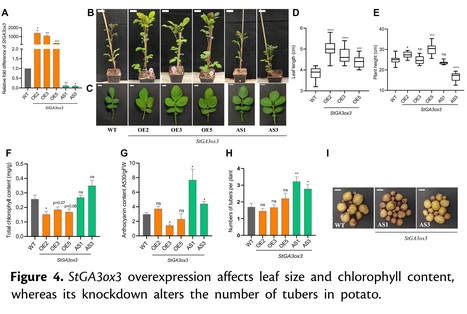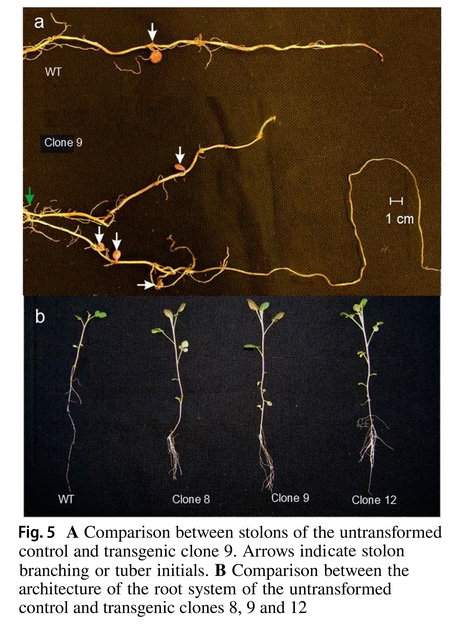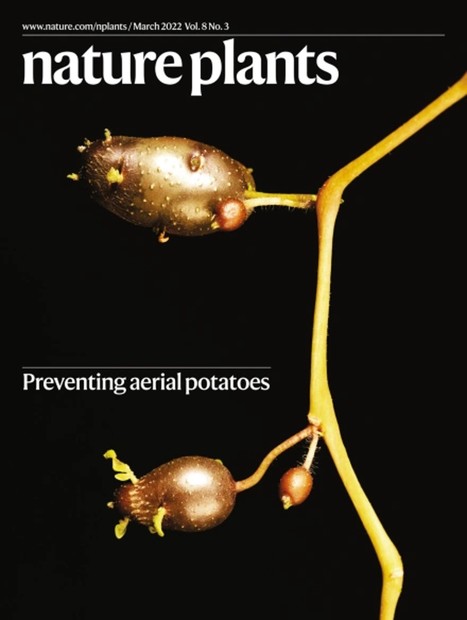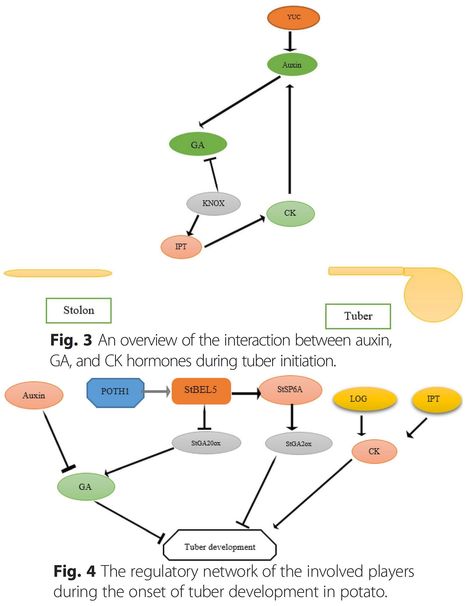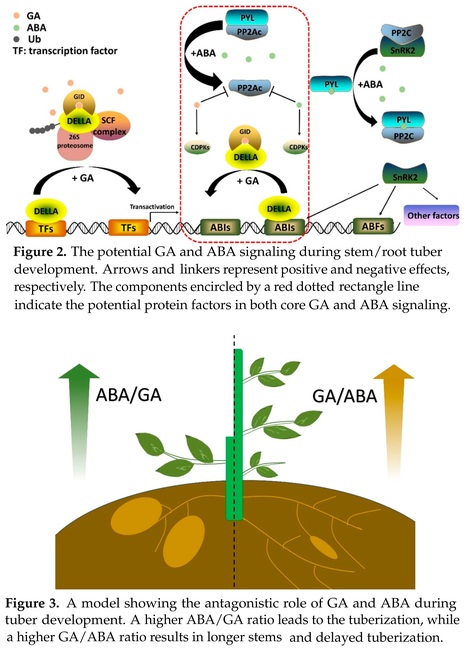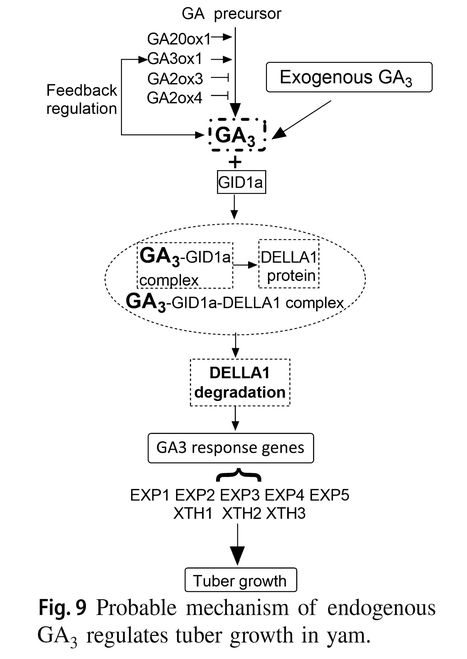 Your new post is loading...
 Your new post is loading...
Authors: Nilam N. Malankar, Kirtikumar R. Kondhare, Kishan Saha, Mohit Mantri, Anjan K Banerjee
Plant Physiology (2023)
Abstract: "Phased short-interfering RNAs (phasiRNAs) fine tune various stages of growth, development, and stress responses in plants. Potato (Solanum tuberosum) tuberization is a complex process, wherein a belowground modified stem (stolon) passes through developmental stages like swollen stolon and minituber before it matures to a potato. Previously, we identified several phasiRNA-producing loci (PHAS) from stolon-to-tuber transition stages. However, whether phasiRNAs mediate tuber development remains unknown. Here, we show that a gene encoding NB-ARC DOMAIN-CONTAINING DISEASE RESISTANCE PROTEIN (StRGA4; a PHAS locus) is targeted by Stu-microRNA482c to generate phasiRNAs. Interestingly, we observed that one of the phasiRNAs, referred as short-interfering RNA D29(-), i.e. siRD29(-), targets the gibberellin (GA) biosynthesis gene GIBBERELLIN 3-OXIDASE 3 (StGA3ox3). Since regulation of bioactive GA levels in stolons controls tuber development, we hypothesized that a gene regulatory module, Stu-miR482c-StRGA4-siRD29(-)-StGA3ox3, could govern tuber development. Through transient expression assays and small RNA sequencing, generation of siRD29(-) and its phase was confirmed in planta. Notably, the expression of StGA3ox3 was higher in swollen stolon compared to stolon, whereas siRD29(-) showed a negative association with StGA3ox3 expression. Antisense (AS) lines of StGA3ox3 produced more tubers compared to wild type. As expected, StRGA4 overexpression (OE) lines had high levels of siRD29(-) and mimicked the phenotypes of StGA3ox3-AS lines, indicating the functionality of this module in potato. In vitro tuberization assays (with or without a GA inhibitor) using StGA3ox3 antisense lines and overexpression lines of StGA3ox3 or StRGA4 revealed that StGA3ox3 controls the tuber stalk development. Taken together, our findings suggest that a phasiRNA, siRD29(-), mediates the regulation of StGA3ox3 during stolon-to-tuber transitions in potato."
Authors: Maria S. Gancheva and Lyudmila A. Lutova.
Plants (2023)
Abstract: "In potato, high levels of nitrogen (N) can lead to excessive vegetative growth at the expense of tuber development, resulting in lower yield and poor-quality tubers. We found that Solanum tuberosum CLE4 (StCLE4) is expressed most strongly in the roots grown in N-rich media, and it positively regulates potato root growth under N-deficient conditions. We noted that StCLE4 functions as a negative regulator of normal shoot apex development similar to CLV3 in Arabidopsis. Transcriptomic analysis revealed that overexpression of StCLE4 resulted in the repression of the StIT1 gene, a regulator of potato tuber initiation. StCLE4-overexpressing stolons were converted into branches, that were similar to a mild phenotype of the it1 (identity of tuber 1) mutant. We also found that NIN-like proteins, key regulators of nitrate signaling bind to the regulatory sequence of StIT1 in a yeast one-hybrid assay. Taken together, our findings suggest that StCLE4 regulates shoot, root, and stolon growth in potato."
Authors: Efstathios Roumeliotis, Bjorn Kloosterman, Marian Oortwijn, Wouter Kohlen, Harro J. Bouwmeester, Christian W. B. Bachem and Richard G. F. Visser.
Potato Research (2022)
Abstract; "Auxin is known to be involved in various developmental processes, including meristem identity, shoot branching and initiation of potato tubers. The previously identified StYUCCA8 gene in potato that exhibits a peak in gene expression after tuber induction and prior to tuber swelling was cloned and over-expressed in order to study the effects of altered auxin content on shoot and stolon architecture and tuber development. The potato plants transformed with the 35S::StYUCCA8 construct exhibited increased shoot and stolon branching, reduced leaf size, lower average tuber fresh weight and enhanced adventitious and lateral root formation. Investigation of the IAA content revealed that the concentration of auxin was not altered in the shoot apex but was significantly lower in the basal part of the stem despite the several 100-fold increase of expression of the StYUCCA8 gene in three independent transgenic clones. This is the first time a potato YUCCA gene is used in an experiment in order to identify the role of endogenous auxin biosynthesis in potato plant development. Our research helps elucidate the importance of small changes of auxin content on several developmental events of the potato plant, such as shoot, stolon and root architecture."
Authors: Michael Nicolas, Rafael Torres-Pérez, Vanessa Wahl, Eduard Cruz-Oró, María Luisa Rodríguez-Buey, Angel María Zamarreño, Beatriz Martín-Jouve, José María García-Mina, Juan Carlos Oliveros, Salomé Prat and Pilar Cubas.
Nature Plants 2022)
Editor's view: In potato, the TCP transcription factor BRANCHED1b represses aerial tuber formation in the axils of the leaves. It functions through limiting the number of plasmodesmata, reducing sucrose levels and repressing the tuberigen protein SP6A.
Abstract: "The control of carbon allocation, storage and usage is critical for plant growth and development and is exploited for both crop food production and CO2 capture. Potato tubers are natural carbon reserves in the form of starch that have evolved to allow propagation and survival over winter. They form from stolons, below ground, where they are protected from adverse environmental conditions and animal foraging. We show that BRANCHED1b (BRC1b) acts as a tuberization repressor in aerial axillary buds, which prevents buds from competing in sink strength with stolons. BRC1b loss of function leads to ectopic production of aerial tubers and reduced underground tuberization. In aerial axillary buds, BRC1b promotes dormancy, abscisic acid responses and a reduced number of plasmodesmata. This limits sucrose accumulation and access of the tuberigen protein SP6A. BRC1b also directly interacts with SP6A and blocks its tuber-inducing activity in aerial nodes. Altogether, these actions help promote tuberization underground."
Authors: Shuhua Huang, Chongyang Zheng, Yan Zhao, Qi Li, Jianwei Liu, Rui Deng, Tiantian Lei, Shufen Wang and Xiaofeng Wang.
Scientia Horticulturae (2021)
Highlights: • Three genes, StBRI1, StBRL1, and StBRL2, were identified in potato genome. • StBRI1 is an active LRR-RLK protein and is highly expressed in tubers. • Overexpression of StBRI1 in bri1-5 plants partially restores BR signaling intensity. • Knockdown of StBRI1 in potato attenuates BR signaling and compromises tuberization.
Abstract: "Brassinosteroids (BRs) play critical functions in a broad range of plant growth and development processes, and components of the BR signaling pathway have been characterized, including the BR receptor, BRASSINOSTEROIDS INSENSITIVE 1 (BRI1). Studies in several crop species have shown that altering the expression of BR receptor genes can result in improved growth, yield and stress-resistance; However, little is known about the role of BR receptors in potato (Solanum tuberosum) tuber development. Here, three potato genes, StBRI1, StBRI1-like 1 (StBRL1), and StBRL2, encoding potential BR receptors, were identified. Expression analysis indicated that StBRI1 was ubiquitously and highly expressed in various potato plant tissues, but especially in tubers. Conserved domain, subcellular localization, and kinase activity analyses revealed that StBRI1 encodes an active leucine-rich repeat (LRR) receptor-like kinase (RLK) protein localized in the plasma membrane. Overexpression of StBRI1 in the Arabidopsis thaliana bri1-5 mutant resulted in partial rescue of the bri1-5 dwarf phenotype and increased BR signaling. RNA interference (RNAi) using partial fragment corresponding to the extracellular region of StBRI1 knocked down the transcription of all three homologs. Transgenic potato plants in which StBRI1 expression was reduced using RNAi exhibited a dwarf phenotype, decreased BR signaling, and reduced tuberization. Regulation of tuberization by StBRI1 was further verified by silencing StBRI1 expression specifically in tubers. Taken together, these results demonstrated that StBRI1 is a functional potato BR receptor and reveals a novel function for brassinosteroid signaling in controlling tuberization."
Authors: Abbas Saidi and Zahra Hajibarat.
Journal of Genetic Engineering and Biotechnology (2021)
Abstract: "Background - Potato is one of the most important food crops worldwide, contributing key nutrients to the human diet. Plant hormones act as vital switchers in the regulation of various aspects of developmental and growth stages in potato. Due to the broad impacts of hormones on many developmental processes, their role in potato growth and developmental stages has been investigated. Main body of the abstract - This review presents a description of hormonal basic pathways, various interconnections between hormonal network and reciprocal relationships, and clarification of molecular events underlying potato growth. In the last decade, new findings have emerged regarding their function during sprout development, vegetative growth, tuber initiation, tuber development, and maturation in potato. Hormones can control the regulation of various aspects of growth and development in potato, either individually or in combination with other hormones. The molecular characterization of interplay between cytokinins (CKs), abscisic acid (ABA), and auxin and/or gibberellins (GAs) during tuber formation requires further undertaking. Recently, new evidences regarding the relative functions of hormones during various stages and an intricate network of several hormones controlling potato tuber formation are emerging. Although some aspects of their functions are widely covered, remarkable breaks in our knowledge and insights yet exist in the regulation of hormonal networks and their interactions during different stages of growth and various aspects of tuber formation. Short conclusion - The present review focuses on the relative roles of hormones during various developmental stages with a view to recognize their mechanisms of function in potato tuber development. For better insight, relevant evidences available on hormonal interaction during tuber development in other species are also described. We predict that the present review highlights some of the conceptual developments in the interplay of hormones and their associated downstream events influencing tuber formation."
Authors: Martin Raspor, Václav Motyka, Slavica Ninković, Jiří Malbeck, Petre I. Dobrev, Snežana Zdravković-Korać, Ana Simonović, Tatjana Ćosić, Aleksandar Cingel, Jelena Savić, Lenka Zahajská, Vojin Tadić and Ivana Č. Dragićević.
Journal of Plant Growth Regulation (2021)
Abstract: "Over the last years, cytokinin deficiency has been studied in a variety of plant species, using transgenic expression of cytokinin oxidase/dehydrogenase genes (CKX). In tobacco and Arabidopsis thaliana, overexpression of A. thaliana CKX genes caused changes in plant morphology known as the "cytokinin deficiency syndrome", including stunted shoot growth, decreased apical dominance, and enhanced root growth. For a valid comparison with the previously obtained in vitro grown AtCKX2-transgenic potato lines, we report here on the construction of transgenic lines of the cultivar Désirée constitutively expressing the gene AtCKX1 under control of the CaMV 35S promoter. Three lines expressing the transgene in both shoot and root tissues were used for analysis. Analyses of CKX activity of tissue extracts, cytokinin levels, morphology, and tuberization parameters revealed similarities as well as differences from the AtCKX2-transgenic plants, including lower levels of CKX activity, and more pronounced morphological effects of cytokinin deficiency. One of the three AtCKX1-overexpressing potato lines was able to start forming tubers before 30 days of growth in long day conditions (16 h/8 h photoperiod) as has been previously observed in some AtCKX2 overexpressors. The extension of the experimental period to 120 days of growth in vitro showed that the other two AtCKX1-overexpressing lines showed impaired tuberization in terms of the number of tubers per plant, and tuber size. We conclude that cytokinin deficiency has distinct effects on tuber induction and tuber initiation/growth, possibly mediated by distinct signaling mechanisms."
|
Authors: José A. Abelenda and Javier Barrero-Gil.
Journal of Experimental Botany (2023)
Abstract: "Despite its prominent role as a stress hormone and its related importance for agriculture, abscisic acid (ABA) molecular signaling is poorly characterized in crops such as potato (Solanum tuberosum). Potato is the world’s third most produced food crop and the most prominent non-cereal in terms of production and consumption (FAOSTAT, 2021). Its importance as a staple food is increasing worldwide. With the immediate need for stress-tolerant and more resilient plants due to changing climate patterns, research on ABA functions in potato will be essential to maintain productivity. Moreover, multiple developmental and physiological aspects of ABA unrelated to abiotic stresses are often overlooked and are difficult to study in plant models. Investigating putative ABA signaling players in potato plants, Liu et al. (2023) have deciphered the negative role of the phosphatase StHAB1 on ABA perception and potato drought stress responses. In addition, the authors provide conclusive evidence that ABA signaling is required for maintaining dormancy in aerial lateral buds. It has long been known that ABA stimulates tuber formation, but the molecular details of such mechanisms remain unknown. It was recently shown that the development of aerial lateral buds leads to a reduction in underground tuber production (Nicolas et al., 2022). Therefore, the ABA-mediated blockage of lateral bud outgrowth reported by Liu et al. (2023) may provide a molecular explanation of the effects of ABA on tuber formation. The transgenic potato lines created in this study offer excellent genetic tools for further study of these connections and have potential biotechnological implications. This work underscores the importance of translational research from models to crops and how it is key not to circumscribe observations to obvious outputs in functional analysis in non-model plants."
Author: Sarah R. Mathura.
AoB PLANTS (2023)
Editor's view: This article reviews the current understanding of the hormone signalling pathways involved in the initiation of the growth of sweet potatoes. It highlights the gaps in the current knowledge of genes involved in the process and suggests future directions to overcome the challenges associated with studying sweet potatoes. This is important for researchers trying to improve sweet potato yields.
Abstract: "Sweet potato (Ipomoea batatas) is an economically important food crop that is grown primarily for its edible storage roots. Several researchers have consequently been conducting studies to increase sweet potato yield, and an important aspect of this research involves understanding how storage root initiation occurs. Although significant progress has been made, several challenges associated with studying this crop have resulted in lagging progress compared to other crops and thus sweet potato storage root initiation is not clearly understood. This article highlights the most important aspects of the hormone signalling processes during storage root initiation that needs to be investigated further and suggests candidate genes that should be prioritized for further study, based on their importance in storage organ formation in other crops. Lastly, ways of overcoming the challenges associated with studying this crop are suggested."
Authors: Peilei Chen, Ruixue Yang, Dorothea Bartels, Tianyu Dong and Hongying Duan.
International Journal of Molecular Sciences (2022)
Abstract: "Abstract Root and tuber crops are of great importance. They not only contribute to feeding the population but also provide raw material for medicine and small-scale industries. The yield of the root and tuber crops is subject to the development of stem/root tubers, which involves the initiation, expansion, and maturation of storage organs. The formation of the storage organ is a highly intricate process, regulated by multiple phytohormones. Gibberellins (GAs) and abscisic acid (ABA), as antagonists, are essential regulators during stem/root tuber development. This review summarizes the current knowledge of the roles of GA and ABA during stem/root tuber development in various tuber crops."
Authors: Shahnewaz Begum, Shenglin Jing, Liu Yu, Xiaomeng Sun, Enshuang Wang, Md Abu Kawochar, Jun Qin, Jun Liu and Botao Song.
The Plant Journal (2022)
Abstract: "Phytohormones and their interaction play critical roles in potato tuberisation. The stimulatory role of jasmonic acid (JA) in tuber development is well established because of its significant promotion of tuber initiation and tuber bulking. However, the dynamics and potential function of JA signalling in potato tuberisation remain largely unknown. The present study investigated the role of the JAZ1 subtype, a suppressor of JA signalling, in potato tuberisation. Using 35S:StJAZ1-like-GUS as a reporter, we showed that JA signalling was attenuated from the bud end to the stem end shortly after tuber initiation. Overexpression of StJAZ1-like suppressed tuber initiation by restricting the competence for tuber formation in stolon tips, as demonstrated by grafting an un-transformed potato cultivar to the stock of StJAZ1-like-overexpressing transgenic potato plants (StJAZ1-like ox). In addition, transcriptional profiling analysis revealed that StJAZ1-like modulates the expression of genes associated with transcriptional regulators, cell cycle, cytoskeleton, and phytohormones. Furthermore, we showed that StJAZ1-like is destabilised upon treatment with abscisic acid (ABA), and the attenuated tuberisation phenotype in StJAZ1-like ox plants can be partially rescued by ABA treatment. Altogether, these results uncovered that StJAZ1-like-mediated JA signalling plays an essential role in potato tuberisation."
Authors: Yunyi Zhou, Yuting Li, Mingxia Gong, Fang Qin, Dong Xiao, Jie Zhan, Aiqin Wang and Longfei He.
Plant Molecular Biology (2021)
Key message: Endogenous and exogenous GA3 responses to DoEXP and DoXTH depend on the DoGA20ox1, DoGA3ox1, DoGA2ox3, DoGA2ox4, DoGID1a, and DoDELLA1 to regulate yam tuber growth.
Abstract: "Yam tuber undergoes significant alteration in morphogenesis and functions during growth, and gibberellins (GA) are considered potentially important regulators of tuber growth. However, it is little known about the regulation of GA metabolism and GA signaling components genes in tuber growth of yam. In this study, the cloning and expressions of GA3 level, GA metabolism and signaling genes, and cell wall genes in tuber growth in response to GA3 and GA biosynthesis inhibitor paclobutrazol (PP333) treatments were studied. The contents of GA3 accumulated at the tuber growth, with the highest levels in the early expansion stage. DoGA20ox1, DoGA3ox1, and four DoGA2ox genes were significantly abundant in the early expansion stage of tuber and gradually declined along with tuber growth. Three DoGID1 and three DoDELLA genes were showed different expression patterns in the early expansion stage of tuber and gradually declined along with tuber growth. Five DoEXP and three DoXTH genes expression levels were higher in the early expansion stage than in other stages. Exogenous GA3 increased endogenous GA3 levels, whereas the expression levels of DoGA20ox1, DoGA3ox1, DoGID1a, and DoDELLA1 were down-regulated in the early expansion stage of tuber by GA3 treatment, DoGA2ox3 and DoGA2ox4 were up-regulated. PP333 application exhibited opposite consequences. Thus, a mechanism of GA3 regulating yam tuber growth by DELLA-dependent pathway is established."
Authors: Wolfgang Zierer, David Rüscher, Uwe Sonnewald and Sophia Sonnewald.
Annual Review of Plant Biology (2021)
Abstract: "Root and tuber crops have been an important part of human nutrition since the early days of humanity, providing us with essential carbohydrates, proteins, and vitamins. Today, they are especially important in tropical and subtropical regions of the world, where they help to feed an ever-growing population. Early induction and storage organ size are important agricultural traits, as they determine yield over time. During potato tuberization, environmental and metabolic status are sensed, ensuring proper timing of tuberization mediated by phloem-mobile signals. Coordinated cellular restructuring and expansion growth, as well as controlled storage metabolism in the tuber, are executed. This review summarizes our current understanding of potato tuber development and highlights similarities and differences to important tuberous root crop species like sweetpotato and cassava. Finally, we point out knowledge gaps that need to be filled before a complete picture of storage organ development can emerge."
|




 Your new post is loading...
Your new post is loading...
